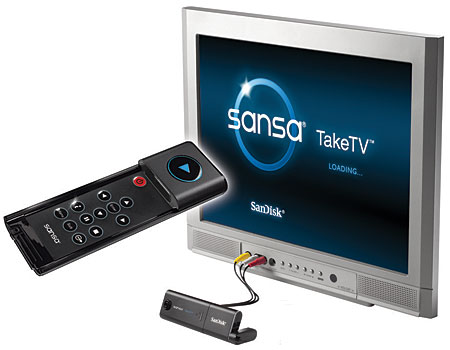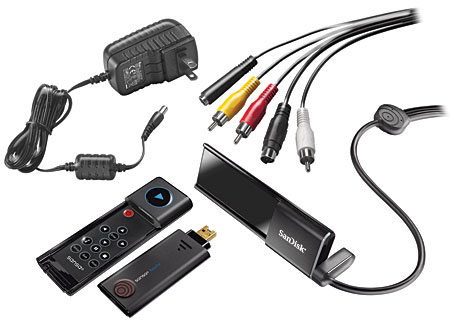SanDisk Sansa TakeTV Video Player
One of my favorite (to make fun of) bits of business-speak is the phrase “leveraging our core competency.” Not content to say, “We’re doing what we do best,” guys in suits spout this lofty verbiage to inspire confidence as they draw upon their unique strength and experience. As the creators of flash memory cards, SanDisk’s core competency has long been those tiny, solid-state wafers in ever-expanding capacities, manufactured in form factors to fit just about every digital device imaginable. They pushed their products in interesting new directions, with dedicated living-room devices that read from and even record to various cards (the SanDisk V-Mate, May 2007 HT). That’s in addition to their broad and popular line of portable MP3 players, with and without video. But with Apple ruling the roost in video-software downloads, and consumers clamoring to watch their digital videos in the comfort of the home theater, what’s next?

Bringin’ the Easy
At the heart of SanDisk’s new Sansa TakeTV is a USB flash memory drive, with either 4 or 8 gigabytes. That’s enough to hold 5 or 10 hours of video, depending upon the file size, which in turn depends upon the file format and bitrate/quality. Thin but wider than a typical thumb drive, it’s not a good fit for a cluttered computer back panel, and SanDisk doesn’t include an extension cable. Substantial cabling balances the dense, diminutive docking cradle, which features a rotating foot so you can either lie it flat or prop it up in your A/V stack. Without leaving anything out, here’s what you do: Plug the TakeTV into your computer, which will recognize it as a new USB drive under Windows XP, and then run the installation file included on the drive. This application will take you to SanDisk’s Fanfare download portal via broadband Internet. In my case, this also meant installing the latest Adobe Flash Player to properly view it. (At press time, Fanfare was a Windows-only service.) The animated interface is busy but sophisticated, with embedded video preview clips. It also includes graphic readouts of the download queue and your progress; it’s quite a pleasant way to shop. Once you’re there, you set up an account and buy any of the videos you like—mostly television content from sources like CBS and Showtime at $1.99 each. Specialty content like celebrity interviews and music videos is free. Purchases download directly to the flash drive, but you can later offload them to your computer to free up space. I quickly found myself wishing that they had sent me the 8-GB unit to test, as I grabbed entire seasons of Dexter and CSI: Miami, at about 600 megabytes per hour-long episode. You can also drag and drop compatible personal videos from your computer directly onto the drive, without the need for a gateway program like iTunes. If you’ve mastered just the basics of computer use, you can surely use this thing.

The name TakeTV hints at this product’s unusual function. You can now disconnect the flash drive from your computer, walk it into the living room, and plug it into the compact, custom-fitted TakeTV cradle that connects to your system via analog stereo and either composite or S-video. Of course, the unspoken allure here is what is not required, namely a home network of any kind (just in case you’ve resisted running Ethernet cable or configuring a wireless access point). Living-room convergence devices like the AppleTV also rely upon the computer to serve as their “filling station.” But they require some sort of active connection, either Ethernet or Wi-Fi, which is up to the user to provide. The SanDisk product, however, is the opposite of Apple’s in that Apple sells iTunes videos primarily for portable use, and only later did they tout living-room viewing as an option. Fanfare downloads are clearly intended for use in the living room, because they will only play through the cradle. So, how do they hold up?
The Ten-Foot Experience
Video downloads arrive in the proprietary SanDisk Media Box Video file format, ending with the .smbv file name extension. I later learned that this is essentially a Digital Rights Management–protected version of the MPEG-4 codec. Again, the TakeTV cradle is currently the only device that can decode the signal, and it’s therefore the only place that an SMBV file will play. The drive automatically powers up when you insert it into the cradle. Or you can use the simple remote, which also fits snugly over the TakeTV drive whenever it is out and about. The device boots quickly to display a list of stored content on the television screen, including folders—and folders within folders, depending on how you choose to organize your videos. Once selected, individual shows take anywhere from 2 to 10 seconds to load.

Four different viewing modes are available. Original offers the sharpest image and truest colors. Fill, Letterbox, and Pan Scan all vie for the chance to variously stretch and zoom the image, which leans toward softness. It’s not blocky, per se, despite its digital origins. (This was over S-video, don’t forget.) Rather, it’s like there’s a thin layer of haze over the entire screen, with some twitchiness on hard lines or soft edges. But it’s most definitely watchable. Sound is clear, if a little flat. Fortunately, the sound is eligible for any processing your receiver might care to add. The TakeTV supports subtitles and alternate audio, although none of my particular downloads offered those options. Easily writable flash memory is built right in, but the TakeTV doesn’t offer a bookmarking function. So, if you leave a program in the middle, you’ll need to start over again. Nor is there a scan button to zip back to that point. Incompatible videos such as certain .mp4 files will take up space, but the TakeTV will not acknowledge them, let alone play them. Actually, the supported formats are relatively few (see the full list in “At A Glance”), but I suppose SanDisk does want to sell their own videos, don’t they?

For anyone who has dabbled in video downloads and removable flash media—and such folks are precisely the target audience here—there is no real learning curve for the TakeTV. You simply plug it in and start using it. With a mouse, credit card, and high-speed Internet connection, you can assemble an evening’s viewing in minutes. And you can move it from your office to the living room in seconds. Expert tech-sperts predict that we’ll all have home networks someday, but viewers eager to bridge the gap right now have found their solution, remote control and all.
Highlights
No network? No problem. Physically carry videos from computer to living room
Backed by SanDisk’s exclusive video download store
- Log in or register to post comments




































































